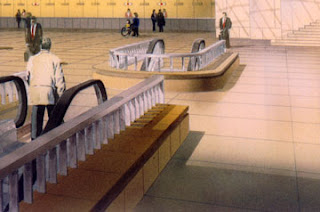Back when I was just a "kid with a dream" I met the preeminent architectural perspectivist, Steve Oles. He was one of those rare people who are both a genius and a gentleman. The gentleman was soft spoken and courteous, with a barely noticeable southern accent. The genius manifested itself as we walked through midtown Manhattan, and he pointed out the various effects of light in the city canyons.
One of his comments regarded the play of sharp and fuzzy shadows cast by the tall buildings and closer structures. I had seen the shadows before, but I hadn't "seen" them. And so, some examples and comments on hard and soft shadows...
This watercolor shows sunset light casting shadows on the wall. Soft shadows on the right from the window opening, and sharp shadows from the lamp and chair.
The same effect shows up in this pastel of the New York Public Library. The soft shadow is cast by the building across 5th Avenue.
The soft gradation on the Woolworth Building above, assumes a low sun catching the tower top only, producing a strong articulation in the sunlight, and a more subdued modeling in the cool shadows.
The typical Beaux-Art elevation, like the entrance above, assumes sharp shadows cast by the elements of the building itself.
This rendering of the same building shows a complex interplay of soft and hard shadows, and window reflections. It is a very un Beaux-Art effect.
Although soft shadows occur most naturally (and usefully) in exterior renderings, a large interior space with glass roof can produce the same soft shadow, which can also be very useful in framing and composing a rendering.
Whereas the sunlit areas show soft and hard shadows, the areas like the parking lot above produce ambient light shadows below and between the cars. These are the "occlusion shadows" that show up as pools of soft darkness between objects in ambient light situations.
These shadows occur all around you all the time. Everyone expects them without realizing it consciously. So use that expectation to rearrange your composition and refocus your rendering.
See also Natural Spotlights.









No comments:
Post a Comment